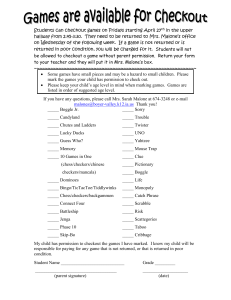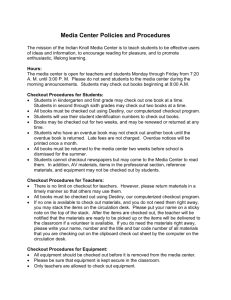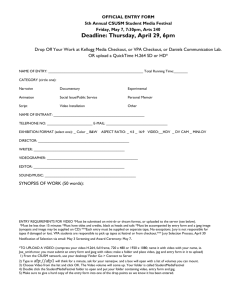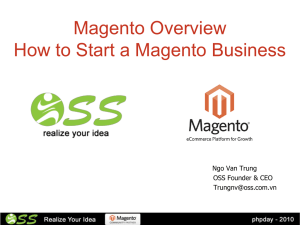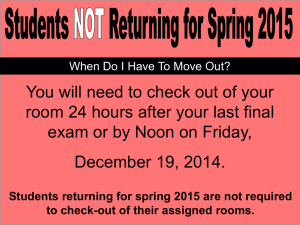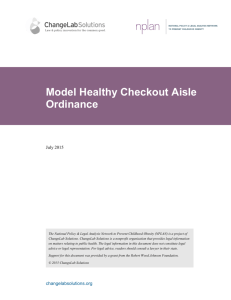Executive Summary
advertisement
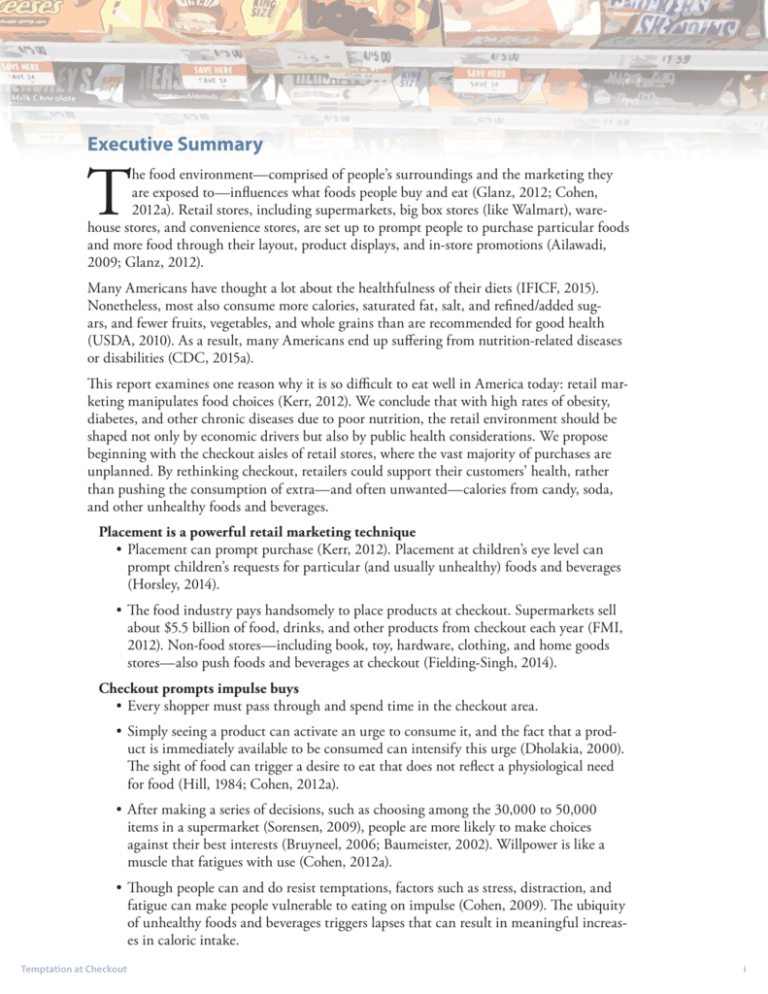
Executive Summary T he food environment—comprised of people’s surroundings and the marketing they are exposed to—influences what foods people buy and eat (Glanz, 2012; Cohen, 2012a). Retail stores, including supermarkets, big box stores (like Walmart), warehouse stores, and convenience stores, are set up to prompt people to purchase particular foods and more food through their layout, product displays, and in-store promotions (Ailawadi, 2009; Glanz, 2012). Many Americans have thought a lot about the healthfulness of their diets (IFICF, 2015). Nonetheless, most also consume more calories, saturated fat, salt, and refined/added sugars, and fewer fruits, vegetables, and whole grains than are recommended for good health (USDA, 2010). As a result, many Americans end up suffering from nutrition-related diseases or disabilities (CDC, 2015a). This report examines one reason why it is so difficult to eat well in America today: retail marketing manipulates food choices (Kerr, 2012). We conclude that with high rates of obesity, diabetes, and other chronic diseases due to poor nutrition, the retail environment should be shaped not only by economic drivers but also by public health considerations. We propose beginning with the checkout aisles of retail stores, where the vast majority of purchases are unplanned. By rethinking checkout, retailers could support their customers’ health, rather than pushing the consumption of extra—and often unwanted—calories from candy, soda, and other unhealthy foods and beverages. Placement is a powerful retail marketing technique • Placement can prompt purchase (Kerr, 2012). Placement at children’s eye level can prompt children’s requests for particular (and usually unhealthy) foods and beverages (Horsley, 2014). • The food industry pays handsomely to place products at checkout. Supermarkets sell about $5.5 billion of food, drinks, and other products from checkout each year (FMI, 2012). Non-food stores—including book, toy, hardware, clothing, and home goods stores—also push foods and beverages at checkout (Fielding-Singh, 2014). Checkout prompts impulse buys • Every shopper must pass through and spend time in the checkout area. • Simply seeing a product can activate an urge to consume it, and the fact that a product is immediately available to be consumed can intensify this urge (Dholakia, 2000). The sight of food can trigger a desire to eat that does not reflect a physiological need for food (Hill, 1984; Cohen, 2012a). • After making a series of decisions, such as choosing among the 30,000 to 50,000 items in a supermarket (Sorensen, 2009), people are more likely to make choices against their best interests (Bruyneel, 2006; Baumeister, 2002). Willpower is like a muscle that fatigues with use (Cohen, 2012a). • Though people can and do resist temptations, factors such as stress, distraction, and fatigue can make people vulnerable to eating on impulse (Cohen, 2009). The ubiquity of unhealthy foods and beverages triggers lapses that can result in meaningful increases in caloric intake. Temptation at Checkout i Checkout sets people up to buy food and drinks that harm their health • The majority of food and beverage checkout offerings are candy, gum, energy bars, chips, cookies, soda, and other sugary drinks (Miller, 2012; Fielding-Singh, 2014; Masterfoods, 2010a). • When food company researchers interviewed shoppers, 60 percent said they had bought candy and 45 percent said they had bought soda from checkout in the past six months (Masterfoods, 2010b). Most people who buy candy or soda from checkout do so at least monthly (Front-End Focus, 2014). • Purchases at checkout do not displace planned purchases; they add to them (Masterfoods, 2010a). • Shoppers who buy candy and soda at checkout are often the same people who deliberately ignore those items in the aisles in the store where they are stocked (Miranda, 2008). Checkout could promote health, as well as sales • Placing foods in prominent places in retail stores increases their visibility, accessibility, and sales. Retailers can nudge customers to select healthier options or non-food items by placing them at checkout. There are examples of healthy checkout projects from communities all over the United States (Haggard, 2014; Wines, 2014; LaRoche, 2014). • Stores already sell a number of non-food items at checkout, including magazines, lip balm, hand sanitizer, USB cables, gift cards, toys, and reusable shopping bags (Fielding-Singh, 2014). They could expand their selection and replace unhealthy foods and beverages with non-food items. • Three major grocery chains in the United Kingdom have already eliminated candy from checkout altogether (Clark, 2014; Craig, 2014; Burrows, 2014). (They rarely carried soda to begin with.) Customer response has been positive (Lidl, 2014). Recommendations • Food stores should adopt food and nutrition standards for checkout, selling only nonfood and healthier food and beverage options there. • Non-food stores should remove food and beverages at checkout. • Like food manufacturers have agreed to policies on food marketing to children, they should voluntarily agree not to use placement fees to induce retailers to place unhealthy foods and beverages at checkout. • Policymakers should implement policies that set nutrition standards for retail checkout, addressing impulse marketing of foods that increase the risk of chronic diseases. • Health departments, other government agencies, hospitals, and other institutions should adopt healthy checkout policies for the properties they own or manage. • Individuals should urge retailers and policymakers to remove unhealthy foods and beverages at checkout. ii Temptation at Checkout


